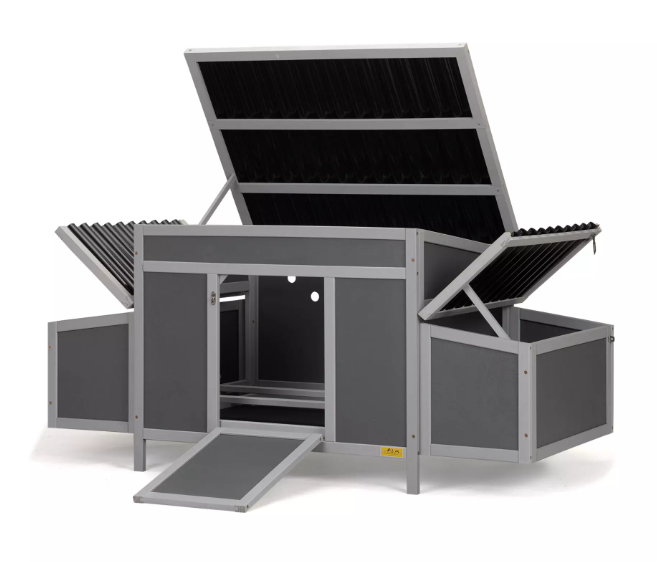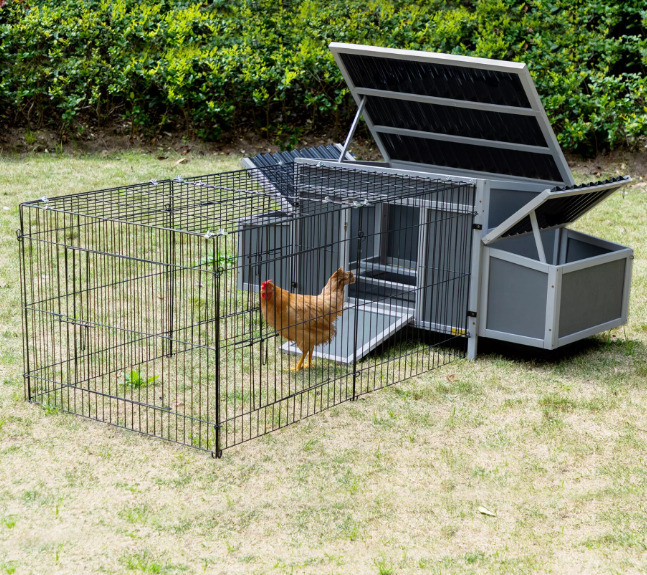Embarking on the journey of raising chickens brings with it a plethora of decisions, one of the most important being the design of the chicken coop. The right coop design not only ensures the comfort and safety of your feathered friends but also contributes to the overall efficiency of your poultry venture. In this guide, we’ll delve into the various factors to consider when choosing the ideal chicken coops design.
Size Matters of Chicken Coop
When it comes to chicken coops, size is a critical factor. Adequate space ensures that your chickens have room to move around comfortably. The general rule of thumb is to allow 2-3 square feet per chicken inside the coop and 8-10 square feet in the outdoor run area. However, these measurements can vary based on factors like breed, climate, and intended usage.
Chicken Coop Style and Materials
Chicken coops for sale come in various styles, each with its own set of advantages. Traditional wooden coops offer insulation and a natural aesthetic, while modern designs might incorporate metal or plastic materials for easy cleaning and durability. Choose a design that complements your backyard and meets the needs of your flock.
Climate Considerations of Chicken Coop
Your geographic location plays a significant role in large chicken coops design. If you live in an area with harsh winters, insulating the coop and ensuring proper ventilation are crucial. In hotter climates, focus on providing shade and adequate airflow. Elevated chicken coops can prevent flooding during rainy seasons.

Predator Protection of Chicken Coop
Predators pose a constant threat to backyard flocks. Incorporate features like secure latches, sturdy wiring, and predator-proof flooring to safeguard your chickens. Consider adding an enclosed outdoor run in chicken coops for additional protection during free-ranging hours.
Ease of Cleaning of Chicken Coop
Maintaining a clean chicken coop is essential for the health of your chickens. Opt for designs that make cleaning and waste removal convenient. Features like removable roosts and nesting boxes, as well as easy-to-access floors, simplify the cleaning process.
Nesting Boxes and Roosting Bars in Chicken Coop
Nesting boxes in the chicken coop provide your hens with private spaces to lay their eggs. Include one nesting box for every 3-4 hens to prevent overcrowding. Roosting bars should be elevated, providing a comfortable and safe place for chickens to rest at night.
Ventilation and Natural Light of Chicken Coop
Proper ventilation prevents moisture buildup and ammonia odors, which can harm your flock. Chicken coops should have windows that can be opened and closed to regulate airflow. Additionally, natural light contributes to the well-being of your chickens, so ensure there’s ample access to sunlight.
DIY vs. Store-Bought for Chicken Coop
Deciding between building your own chicken coop and purchasing a pre-made one depends on your skills, time, and budget. DIY walk in chicken coops offer customization options and a sense of accomplishment, while store-bought chicken run coop provide convenience and instant setup.

Future Expansion of Chicken Coop
As your flock grows, your chicken coop needs may change. When designing your chicken coop, consider future expansion possibilities. Build a coop that can be easily modified or expanded without major renovations.
Integration with Your Lifestyle for Chicken Coop
When choosing a chicken coop design, it’s important to consider how it fits into your daily routine and lifestyle. If you have limited time for coop maintenance, opt for designs that are low-maintenance and easy to clean. On the other hand, if you enjoy DIY projects and have the time to invest, a more intricate custom design might be appealing.
Local Regulations and Zoning of Chicken Coop
Before finalizing your chicken coop design, research local regulations and zoning laws that pertain to keeping backyard chickens. Some areas have restrictions on coop size, placement, and even the number of chickens you can have. Ensure that your chosen design aligns with these regulations to avoid potential issues down the line.
Budget-Friendly Options for Chicken Coop
Building a chicken coop doesn’t have to break the bank. There are budget-friendly coop design options available that utilize repurposed materials or simple designs. Consider using recycled wood or repurposing existing structures to create a cost-effective yet functional coop for your flock.
Functional Design Elements of Chicken Coop
Think about the practical aspects of your coop design. Incorporate features like easy-to-access feeders and waterers, secure locks, and removable panels for efficient cleaning. A well-organized chicken coop layout can streamline your daily chores and make caring for your chickens a breeze.
Seeking Expert Advice for Chicken Coop
If you’re unsure about the best chicken coop design for your flock, don’t hesitate to seek advice from experienced chicken keepers or professionals. Local agricultural extension offices, poultry forums, and even coop design consultants can provide valuable insights and recommendations.
Regular Maintenance and Upkeep of Chicken Coop
Once your modern chicken coop is built, ongoing maintenance is essential. Regularly inspect and repair any wear and tear, update bedding, and address any structural issues promptly. Proper maintenance ensures a safe and comfortable environment for your chickens.
Selecting the right chicken coop design is a significant decision that impacts the well-being of your chickens and the success of your poultry venture. Remember, a well-designed chicken coop not only provides a safe and comfortable habitat for your chickens but also sets the stage for a rewarding experience as you embark on your journey of raising healthy and happy poultry.
https://www.almanac.com/raising-chickens-101-how-build-chicken-coop

